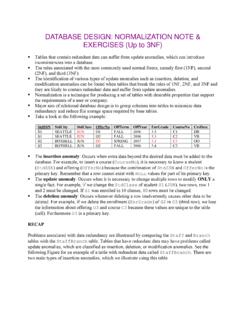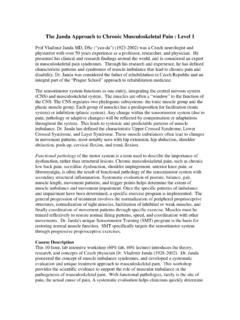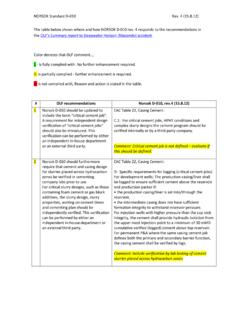Transcription of Health Benefits of Yoga - CAEYC
1 Health Benefits of yoga Trisha Lamb Two of the most common inquiries we receive from professional members preparing presentations on yoga and from journalists and students writing about yoga are: What are the Health Benefits of yoga ? How does yoga differ from conventional exercise? Following are answers drawn from various sources and provided in a succinct format. I wish to especially thank the following three individuals: First, A. Malathi, for her presentation in November 2000 on the Benefits of yoga at Sutter Medical Center in Santa Rosa, California. Her paper Promotive, Prophylactic Benefits of Yogic Practice in Middle Aged Women furnishes research results and explanations for many of the Benefits noted below.
2 Thanks also to IAYT member Matra Majmundar for her presentation on yoga physiology at the Integrating yoga Therapeutics into Rehabilitation seminar at San Francisco Memorial Hospital in April 2000. Her book, tentatively titled Physiology of yoga Therapeutics, is in preparation. I also would like to thank Arpita for her article The Physical and Psychological Benefits of yoga , which appeared in the 1991 issue of The Journal of The International Association of yoga Therapists. Bibliographic details for these and other references are provided at the end of this article. Health Benefits This information is grouped into three categories physiological Benefits , psychological Benefits , biochemical effects and is based on the regular practice of traditional sana, pr n y ma, and meditation.
3 Please note that while pulse rate, etc., may increase during the practice of various sanas, some forms of pr n y ma, and some stages of meditation, but overall Benefits to general Health are as listed below. For information on the physiological changes that occur during the practice of specific sanas, etc., please see James Funderburk s Science Studies yoga and other resources cited at the end of this article. Physiological Benefits Stable autonomic nervous system equilibrium, with a tendency toward parasympathetic nervous system dominance rather than the usual stress-induced sympathetic nervous system dominance Pulse rate decreases Respiratory rate decreases Blood pressure decreases (of special significance for hyporeactors) Galvanic Skin Response (GSR) increases EEG - alpha waves increase (theta, delta, and beta waves also increase during various stages of meditation)
4 EMG activity decreases Cardiovascular efficiency increases Respiratory efficiency increases (respiratory amplitude and smoothness increase, tidal volume increases, vital capacity increases, breath-holding time increases) Gastrointestinal function normalizes Endocrine function normalizes Excretory functions improve Musculoskeletal flexibility and joint range of motion increase Posture improves Strength and resiliency increase Endurance increases Energy level increases Weight normalizes Sleep improves Immunity increases Pain decreases Psychological Benefits Somatic and kinesthetic awareness increase Mood improves and subjective well-being increases Self-acceptance and self-actualization increase Social adjustment increases Anxiety and depression decrease Hostility
5 Decreases Psychomotor functions improve: o Grip strength increases o Dexterity and fine skills improve o Eye-hand coordination improves o Choice reaction time improves o Steadiness improves o Depth perception improves o Balance improves o Integrated functioning of body parts improves Cognitive function improves: o Attention improves o Concentration improves o Memory improves o Learning efficiency improves o Symbol coding improves o Depth perception improves o Flicker fusion frequency improves Biochemical Effects The biochemical profile improves, indicating an antistress and antioxidant effect, important in the prevention of degenerative diseases.
6 Glucose decreases Sodium decreases Total cholesterol decreases Triglycerides decrease HDL cholesterol increases LDL cholesterol decreases VLDL cholesterol decreases Cholinesterase increases Catecholamines decrease ATPase increases Hematocrit increases Hemoglobin increases Lymphocyte count increases Total white blood cell count decreases Thyroxin increases Vitamin C increases Total serum protein increases Oxytocin increases Prolactin increases Oxygen levels in the brain increase yoga Compared to Conventional Exercise yoga Exercise Parasympathetic nervous system dominates Sympathetic nervous system dominates Subcortical regions of brain dominate Cortical regions of brain dominate Slow dynamic and static movements Rapid forceful movements Normalization of muscle tone Increased muscle tension Low risk of injuring muscles and ligaments High risk of injury Low caloric consumption Moderate to high caloric consumption Effort is minimized, relaxed Effort is maximized Energizing (breathing is natural or controlled) Fatiguing (breathing is taxed)
7 Balanced activity of opposing muscle groups Imbalanced activity of opposing groups Noncompetitive, process-oriented Competitive, goal-oriented Awareness is internal (focus is on breath and the infinite) Awareness is external (focus is on reaching the toes, reaching the finish line, etc.) Limitless possibilities for growth in self- awareness Boredom factor Select General References Anantharaman, V., and Sarada Subrahmanyam. Physiological Benefits in hatha yoga training. The yoga Review, 3(1):9-24. Arpita. Physiological and psychological effects of Hatha yoga : A review of the literature. The Journal of The International Association of yoga Therapists, 1990, 1(I&II):1-28.
8 Bhole, M. V. Some neuro-physiological correlates of yogasanas. yoga -Mimamsa, April 1977, 19(1):53-61. Cole, Roger. Physiology of yoga . Iyengar yoga Institute Review, Oct 1985. Corby, J. C., W. T. Roth, V. P. Zarcone, Jr., and B. S. Kopell. Psychophysiological correlates of the practice of Tantric yoga meditation. Archives of General Psychiatry, May 1978, 35(5):571-577. Davidson, Julian M. The physiology of meditation and mystical states of consciousness. Perspectives in Biology and Medicine, Spring 1976, 19:345-379. Delmonte, M. M. Physiological concomitants of meditation practice. International Journal of Psychosomatics, 1984, 31(4):23-36.
9 _____. Physiological responses during meditation and rest. Biofeedback Self Regulation, Jan 1984, 9(2):181-200. _____. Biochemical indices associated with meditation practice: A literature review. Neuroscience and Biobehavioral Reviews, Winter 1985, 9(4):557-561. Dostaleck, C. Physiological bases of yoga techniques in the prevention of diseases. CIANS-ISBM Satellite Conference Symposium, Hanover, Germany, 1992: Lifestyle changes in the prevention and treatment of disease. Homeostasis in Health and Disease, 1994, 35(4-5):205-208. Ebert, Dietrich. yoga from the point of view of psychophysiology. yoga -Mimamsa, 28(4):10-21. Elson, Barry D.
10 , Peter Hauri, and David Cunis. Physiological changes in yoga meditation. Psychophysiology, January 1977, 14:52-57. Engel, K. Meditation, Vol. 2: Empirical Research and Theory. Frankfurt, Germany: Peter Lang, 1997. Funderburk, James. Science Studies yoga : A Review of Physiological Data. Honesdale, Penn.: Himalayan International Institute, 1977. Gopal, K. S., O. P. Bhatnagar, N. Subramanian, and S. D. Nishith. Indian Journal of Physiology and Pharmacy, 1973, 17(3):273-276. Jevning, R., R. K. Wallace, and M. Beidebach. The physiology of meditation: A review. A wakeful hypometabolic integrated response. Neuroscience and Biobehavioral Reviews, Fall 1992, 16(3):415-424.









